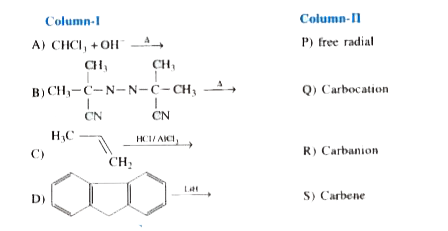(A) : The number of isomeric amines possible for the formula C3H9N is four
(R ): Primary, secondary and tertiary amines are functional isomersSolution in Telugu
A and R are true, R explains A
A and R are true, R does not explain A
A is true, but R is false
A is false, but R is true
The correct Answer is:B
Step by step video, text & image solution for (A) : The number of isomeric amines possible for the formula C_(3)H_(9)N is four (R ): Primary, secondary and tertiary amines are functional isomers by Chemistry experts to help you in doubts & scoring excellent marks in Class 11 exams.
Updated on:21/07/2023Topper's Solved these Questions
- GENERAL ORGANIC CHEMISTRYBOOK - AAKASH SERIESCHAPTER - GENERAL ORGANIC CHEMISTRYEXERCISE - Objective Exercise -2
82 Videos
- GENERAL ORGANIC CHEMISTRYBOOK - AAKASH SERIESCHAPTER - GENERAL ORGANIC CHEMISTRYEXERCISE - Practice Exercise
80 Videos
- GENERAL ORGANIC CHEMISTRYBOOK - AAKASH SERIESCHAPTER - GENERAL ORGANIC CHEMISTRYEXERCISE - Subjective Exercise -8
120 Videos
- ENVIRONMENTAL CHEMISTRYBOOK - AAKASH SERIESCHAPTER - ENVIRONMENTAL CHEMISTRYEXERCISE - EXERCISE ON PASSAGE (PASSAGE-III)
5 Videos
- HYDROCARBONSBOOK - AAKASH SERIESCHAPTER - HYDROCARBONSEXERCISE - ADDITIONAL PRACTICE SHEET ( LEVEL-II (PRACTICE SHEET (ADVANCED) (MATRIX MATCHING TYPE QUESTIONS)))
5 Videos
Similar Questions
The compound containing sp sp2 and sp3 hybridised carbon atoms in 1:2:3 ratio is
View SolutionThe compound CH3−CH∣CH3−CH∣CH3−CH3 contains
View SolutionExplain the estimation of nitrogen of an organic compound by
(a) Dumas method and (b) Kjeldahl's method
View SolutionOzone layer acts as one of the most important life support system. The major cause of ozone layer destruction is believed to be the release of chlorofluorocarbon compounds. UV radiation causes the chlorofluouocarbons to dissociate : CF2Clhv−−→Cl⋅+CF2CI A highly reactive chlorine atomis responsible for the decomposition of ozone. Cl⋅+O3(g)→ClO⋅+O2(g)ClO⋅+O(g)→Cl⋅+O2(g) Free radicals of chlorine decompose ozone molecules in a chain reaction. The depletion of ozone layer leading to ozone hole has, however, been mainly observed in the stratosphere over Antarctica. Special type of cloud called polar stratospheric colouds are formed over Antarctica.These clouds (contain solid HNO3.3H2O) play an important role in ozone depletion.
ClO⋅+NO2→ClONO2
ClONO2+H2O→HOCl+HNO3
ClONO2+HCl→Cl2+HNO3
HOClhv−−→HO⋅+Cl⋅
The reactive chlorine atoms thus formed are rendered to deplete ozone layer.
The ozone layer is present in :
View SolutionMatch the intermediates formed in the reaction.

View SolutionHow many structrual isomers of tertiary amines corresponding to molecular formula C6H15N are possible?
View SolutionThe number of primary, secondary and tertiary amines possible with the molecular formula C_(3)H_(9)N respectively.
View SolutionThe number of isomeric amines possible for the formula C3H9N
View SolutionThe number of primary, secondary and tertiary amines possoble with the molecular formula C3H9N respectively :
View SolutionDraw the structures, give names according to IUPAC and indicate primary, secondary and tertiary amines : (a) eight isomeric amines of formula C_(4)H_(11)N . (b) five isomeric amines of formula C_(7)H_(9)N that contain a benzene ring.
View SolutionFour structural isomers are possible corresponding to the molecular formula C_(3)H_(9)N . Out of these, two are primary amines which are position isomers. All are more basic than aniline. 6. Write the structural formula and IUPAC name of tertiary amine having the above molecular formula.
View SolutionHow many isomeric amines with the formula C7H9N contain a benzene ring and also primary amine functional group?
View SolutionNumber of saturated isomeric primary amines possible for the molecular formula C3H5N is
View SolutionThe number of primary, secondary and tertiary amine isomers possible for the compound with formula C_(4)H_(11)N are
View SolutionThe number of isomeric amines possible for the formula C3H9N
View Solution
